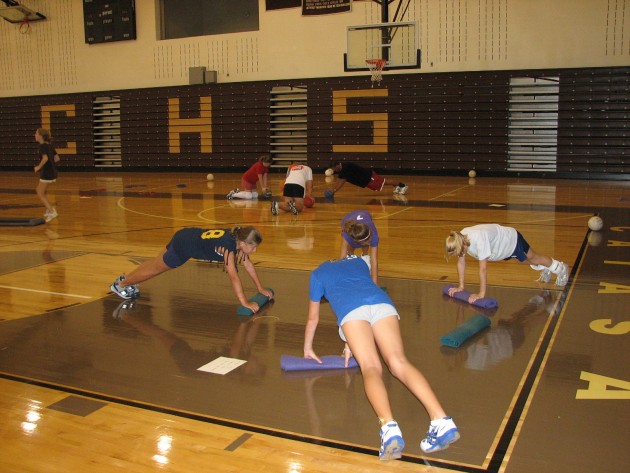
Volleyball training
Being an efficient athlete. Being an efficient athlete means performing your sport without wasted movement. By continuing to refine your volleyball training, you will gain confidence and reduce any anxiety about being prepared for competition.
By learning to train more efficiently, you will feel more athletic and volleyball skills will seem easier to master.
Bodybuilding vs. functional training. A typical bodybuilding program is very different than functional strength training. The goal of bodybuilding is about improving muscle size and symmetry. Just because an athlete gets bigger and stronger doesn’t mean they are able to transfer that added muscle to their sports performance.
It may be easier to design workouts with exercises that isolate individual muscles, but by doing so makes it difficult to get muscles to work together as an integrated system.
The focus of functional training is on developing movement. The goal of training is not to change how the body looks, but to improve how the body moves.
Developing a better body. A great body is often a by-product of functional training. In fact, many personal trainers use the concepts of functional training in their programs when training their clients.
Training the kinetic chain. Rather than focusing on individual muscles, your volleyball training should involve moving multiple body parts.
Movement is complex, requiring the interaction of multiple muscle groups moving in all three planes of movement. Training should involve all the links in your body’s kinetic chain working together to produce efficient movement.
Correcting and Improving Movement Patterns
Poor biomechanics. Poor biomechanics refers to the movement mistakes in which the body compensates and uses suboptimal joint alignment, muscle coordination, and posture.
Because these tiny errors in movement efficiency don’t affect your sports performance, you usually won’t be aware of any problems. You may get away with poor mechanics for awhile, but eventually these inefficiencies will start causing problems.
Overtraining. Many people make the mistake of blaming microtraumas (small injuries) on overtraining. Overtraining is the result of doing too much of the right thing and not enough rest and recovery, but this is often not the cause of microtraumas. Microtraumas often occur because of a weak link in your body’s chain of movement.
Conditioning vs. neuromuscular training. Weak links can be the cause of many physical limitations such as poor movement patterns, flawed coordination, incomplete sport skill, or lack of flexibility.
Before starting a conditioning program, it may be best to identify a weak link in your chain of movement. Once identified, focus on developing that weakness at the beginning of your volleyball training cycle.
If you don’t correct weaknesses, you will continue to reinforce poor technique and flawed neuromuscular compensation patterns. Being a balanced athlete is key. Without balance you won’t be efficient, and then strength and power can’t be maximized.
Injury and Recovery
Soreness or pain? Soreness comes from hard work and training. Pain indicates that there is a problem that needs to be fixed to prevent further damage. Many athletes continuously push through the pain when they train and compete.
Many athletes commonly use ice and anti-inflammatory medications to the mask pain over a long time. Pain is a warning that something is wrong. Pain should be seen as a signal that something is not right.
Pain distorts proprioception. Listen to your body throughout your volleyball training phases. Each workout session can improve motor learning, coordination, and movement patterns. If pain distorts your body awareness, then chances are you will compensate and use unusual movements to avoid the pain.
Compensating movement patterns. Compensation is basically your body looking for the best substitute available to perform a movement. Compensation creates stress in other parts of the body as other areas work harder to achieve the same level of performance.
New problems arise when normal body parts must work in abnormal situations or the athlete pushes into the pain, risking even greater injury with more complications.
Testing functional movement. There are ways to test for compensation patterns. Gray Cook has developed a movement screen for testing both static and dynamic movements. These movement tests can be used by just about anyone. For more information on Gray Cook’s movement screen, check out the FMS Website.
Many of these tests can be done by oneself and basically involve analyzing an athlete’s mobility and stability by moving through active ranges of motion and performing static postures.
Functional strength tests can also be done to identify a volleyball players strengths and weaknesses.
Determine the cause of pain. A better understanding of muscle function will allow your volleyball training to be more focused, logical, and exact.
An understanding of the importance of training to be more functional shifts the focus of “no pain, no gain” and “feel that burn” to feeling the free flow and rhythm of efficient movement.
Muscular imbalances. Pain could simply be caused by a muscle imbalance that has produced unnecessary stress in a joint or tendon. Covering up the symptom and pushing the joint further into activity can cause more damage.
Muscular imbalances at the shoulder joint are often caused by scapular muscle dysfunction which may lead to volleyball injuries at the rotator cuff. Your volleyball training should include shoulder stability exercises that target movement and stabilization of the scapulae.
By denying the pain you are ignoring one of the keys to refining your volleyball training. It is important to get to the bottom of what causes the pain.
If it is caused by a single injury, it is easy to find the cause. If it has been developing over for a long period, find out what caused it, where it came from, and what can be done to prevent future problems.
Read more articles from our Fitness section.
Check out our Stretching section, every Sunday a new story! Tomorrow read about Forcible Stretching of a Muscle